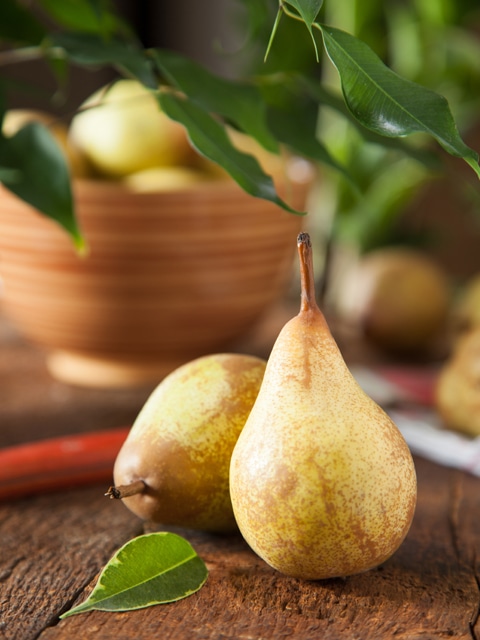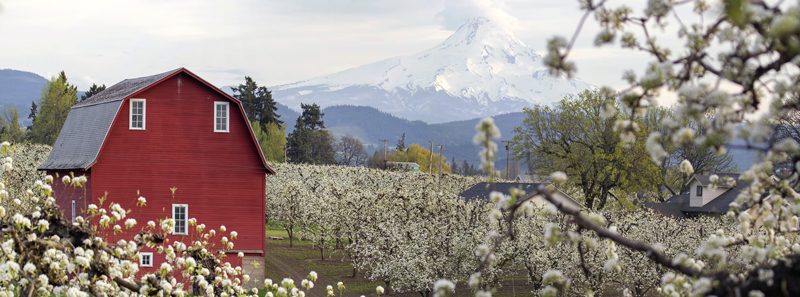


 Add to favorites
Add to favorites
 There are more than three thousand different varieties of pears… 3,000 (had to see that in number form to really get it to sink in.) Bob and I grow two organic versions; Bosc and Bartlett. There is something very grounding when it comes to growing your own food.
There are more than three thousand different varieties of pears… 3,000 (had to see that in number form to really get it to sink in.) Bob and I grow two organic versions; Bosc and Bartlett. There is something very grounding when it comes to growing your own food.
Pears are high in both soluble and insoluble fiber. But did you know that the skin of a pear contains about half of the pear’s total dietary fiber? We have always heard that it is best (if possible) to eat the skins of the fruits.
But fiber isn’t the only reason… According to WHFoods, “Studies have shown that the skin of pears contains at least three to four times as many phenolic phytonutrients as the flesh. These phytonutrients include antioxidant, anti-inflammatory flavonoids, and potentially anti-cancer phytonutrients like cinnamic acids.”
So I am going to highly suggest that you enjoy that pear, skin and all EXCEPT if it isn’t organic. I am not too sure that the fiber payoff trumps the pesticide consumption. You can make that call. I know it isn’t always feasible to afford or find organic produce, just do your best.
There is something quite magical about a perfectly ripened pear. But there lies the conundrum… finding the perfect pear. The road to pearadise is a long and difficult one. Truth be told, you won’t find a perfectly ripened pear at the grocery store. You are the one in change on holding space so the pear can mature into pear-fection. You see, there is a small window from when they go from being crunchy hand grenades of fruit to where they collapse into a mushy puddle in the bottom of the fruit bowl. I think it is about a 10-minute window and if you aren’t there to catch it… well then… you have missed that Pear-fecta moment in time.
Once you cut into a pear, you are pretty much committed to eating it up because like many fruits, the flesh cut or peeled pears will eventually brown. This is a natural oxidation process that doesn’t affect the taste or quality… just the aesthetics. To keep them looking appetizing and to prevent browning, dip them in a mild solution of 50% water and 50% lemon juice.
I don’t typically freeze pears. I have attempted to in the past but they tend to discolor and turn mushy upon thawing. It is usually recommended to blanch them in hot water and coat them with a sugar solution to better preserve them if freezing them. I either enjoy them fresh or dehydrate them.
Pears are in their peak come Fall, but you can dehydrate them when they are ripe and abundant… allowing you to enjoy them year round. It is easy to and if you wish to learn how to dehydrate pears, click (here). I have used dried pears for decorating desserts but mainly just for plain ole snacking. Check out my Hazelnut Pear Cake with Velvety Honey Pear Frosting.

Pear Orchard in Hood River, Oregon
While Bartlett’s skin color brightens as it ripens, most varieties of pears show little change in color. So we are going to have to go by the touch and feel method. Apply gentle pressure to the neck of the pear with your thumb. If it yields to pressure, it’s ripe. But as I mentioned above, you won’t be leaving the grocery store with a bag of ripe pears, this is where your time and patience come into play. You will want to leave the unripe pears at room temperature so that they can ripen. Once the pear is ripe, EAT IT! But if you can’t, it can be refrigerated to slow the ripening process and saved for use up to five days later… but I would EAT IT! lol
If you are impatient and want that pear to ripen as soon as possible…. you can speed up the ripening process, by putting the pear(s) inside a brown paper bag, roll the edges down, and wait. I can’t say for sure how long it will take but it will be quicker than just watching it as it sits on the countertop.